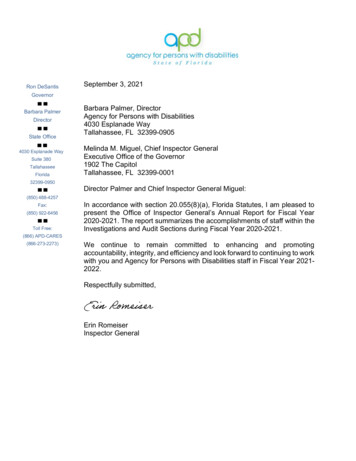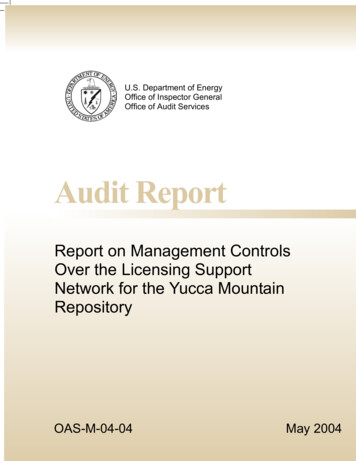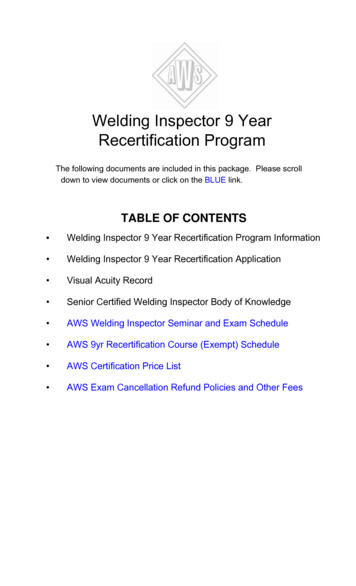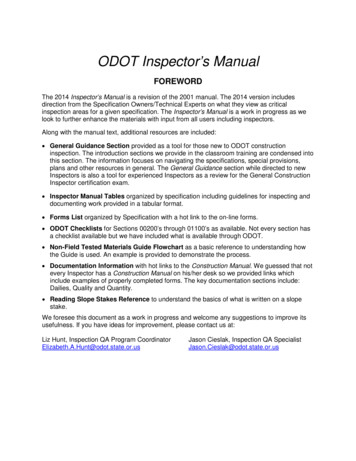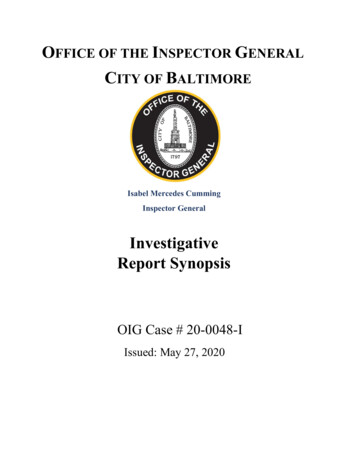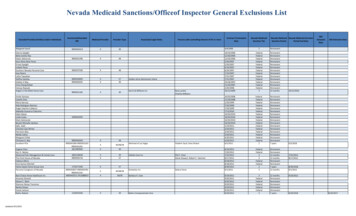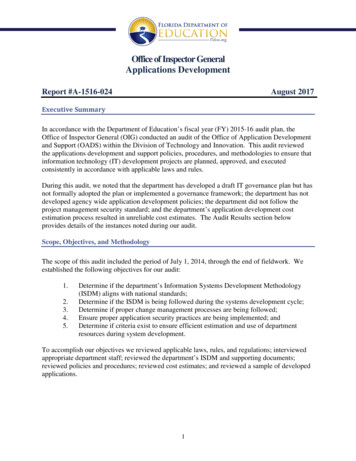
Transcription
Office of Inspector GeneralApplications DevelopmentReport #A-1516-024August 2017Executive SummaryIn accordance with the Department of Education’s fiscal year (FY) 2015-16 audit plan, theOffice of Inspector General (OIG) conducted an audit of the Office of Application Developmentand Support (OADS) within the Division of Technology and Innovation. This audit reviewedthe applications development and support policies, procedures, and methodologies to ensure thatinformation technology (IT) development projects are planned, approved, and executedconsistently in accordance with applicable laws and rules.During this audit, we noted that the department has developed a draft IT governance plan but hasnot formally adopted the plan or implemented a governance framework; the department has notdeveloped agency wide application development policies; the department did not follow theproject management security standard; and the department’s application development costestimation process resulted in unreliable cost estimates. The Audit Results section belowprovides details of the instances noted during our audit.Scope, Objectives, and MethodologyThe scope of this audit included the period of July 1, 2014, through the end of fieldwork. Weestablished the following objectives for our audit:1.2.3.4.5.Determine if the department’s Information Systems Development Methodology(ISDM) aligns with national standards;Determine if the ISDM is being followed during the systems development cycle;Determine if proper change management processes are being followed;Ensure proper application security practices are being implemented; andDetermine if criteria exist to ensure efficient estimation and use of departmentresources during system development.To accomplish our objectives we reviewed applicable laws, rules, and regulations; interviewedappropriate department staff; reviewed the department’s ISDM and supporting documents;reviewed policies and procedures; reviewed cost estimates; and reviewed a sample of developedapplications.1
Report #A-1516-024August 2017BackgroundThe Office of Application Development and Support (OADS) within the Division of Technologyand Innovation provide internal information technology (IT) consulting services to departmentoffices. OADS is responsible for systems development, systems support, data administration,and web development. OADS also establishes enterprise wide standards relative to theseservices.OADS works in partnership with its customers to identify needs and develop applications thatsupport their business functions. OADS currently manages 362 applications. On March 14,2013, the Chief Information Officer approved the Information Systems DevelopmentMethodology (ISDM). The ISDM or System Development Life Cycle (SDLC) provides a set ofprocesses, standards, and best practices to be used in the development of software applications.These processes include project initiation, planning, design, development, testing, andimplementation. The methodology ensures that all projects are developed with consistentstandards and ensures system continuity.The purpose of the IT Project Management Standard is to specify requirements for compliancewith the department’s information technology policies, other department policies, and applicablelaws and regulations. The standard describes the project management methodology that guidesall IT projects. The Project Management Standard includes an initiation phase, planning phase,execution phase, monitoring and controlling phase, and closeout phase. Per the standard, themajority of the execution phase activities and documentation will be associated with thedepartment’s SDLC process and requirements. See Table 1 1 for the Project Management LifeCycle and ISDM activities.1The department performs risk and complexity assessments for the IT projects to determine the minimum level ofproject control necessary. Most of the project management steps are optional unless the project is deemed tohave higher risk and complexity.2
Report #A-1516-024August 2017Table 1 2While the Systems Development Methodology and Project Management Methodology aresimilar, they are not the same. The two methodologies should never compete against each otherduring the development of an IT project, nor should you attempt to execute a developmentproject using just one of the methodologies. In fact, the two methodologies should complementeach other during system development projects to ensure successful development of ITprojects. 3 Currently there is no department policy requiring the use of either the ProjectManagement Standard or the ISDM.We requested all applications developed and all IT projects overseen by OADS from July 1,2014, through May 1, 2017. The department identified the Bureau of Educator Certification(BEC) Enterprise Licensing Project and the Statewide Course Numbering System (SCNS). Perthe BEC Project Charter, “The original BEC Project, began in 2013, adopted an in-housedevelopment effort to try to refresh hardware and operating systems to current standard and thenrecode applications to current supportable software.” Absent IT governance oversight, thecontractors spent excessive time stabilizing and documenting the old system. After two years indevelopment, the project stalled due to the complexity and challenge of trying to upgrade thecurrent system. As a result, department management assigned the maintenance for the currentBEC Enterprise Licensing Project to OADS and assigned a new project manager to assess the2Items with asterisks (*) were not included in the department’s Project Management Life Cycle or the SystemDevelopment Life otapmmethodology/3
Report #A-1516-024August 2017development project and get it back on track. The project team and business sponsorsunanimously agreed that a wholesale replacement of the system was needed. Through additionalassessment, the project team identified a customizable off-the-shelf solution that met BEC’sbusiness requirements. Subsequently, the department purchased an off-the-shelf softwaresolution for the BEC Enterprise Licensing Project and is customizing the software based on itsspecific needs. The project oversight team followed the department’s Project ManagementStandard, but the project did not follow the department’s ISDM. We determined that the projectoversight team completed all requirements in the department’s Project Management Standardwith the exception of the security requirements identified in the Florida Cybersecurity Standards.SCNS is a uniform system for numbering courses across public higher education institutions.The assigned numbers describe course content to improve research, assist program planning, andfacilitate the transfer of students. The system was developed in 2003 using technology that is nolonger supported by the department. The purpose of the SCNS project is to transition the currentlegacy system from its existing Java/Oracle technology to a new system that uses Microsoft’sStructured Query Language database and .Net programming technologies. SCNS was initiallyconsidered a maintenance task; however, due to the complexity, timeframe, age of the system,and inexperience of the staff in JAVA, OADS converted the task to a project in May 2016. Theproject oversight team followed the department’s Project Management Standard. We determinedthat the project oversight team completed most requirements in the department’s ProjectManagement Standard but failed to complete the security requirements identified in the FloridaCybersecurity Standards, a Business Case and Alternative Analysis, a Cost Benefit AnalysisPlan, a Resource Plan, a Project Spending Plan, or an Operation & Management Plan. TheSCNS project is currently over budget. A cost estimate was completed in April 2016 with anestimated cost of 126,336.00. On April 25, 2017, OADS submitted an ApplicationDevelopment Request (ADR) form to request a true up of hours for the SCNS project andrequest additional hours. The new projected cost totals 379,497.80, exceeding the originalestimated cost by 253,161.80. The Audit Results section below provides details of theidentified deficiencies.Findings1: The department lacks an overall IT governance framework.Gartner defines IT governance as, “the processes that ensure the effective and efficient use of ITin enabling an organization to achieve its goals.” Project governance provides business andproject managers, the project team, project sponsors and all stakeholders with the structure,processes, decision‐making models, and tools to ensure the successful management of the projectand delivery of the end product. Governance provides a framework for making project decisionsand defining roles, responsibilities, and accountabilities to ensure the success of the project.The OIG completed a consulting engagement to assist with the development of the department’sIT governance plan in August 2016. That review noted that prior efforts to establish ITgovernance were largely unsuccessful. The engagement concluded with the departmentdeveloping an Enterprise Project Management Governance Plan. According to the department’sdraft Project Management Governance Plan, the project governance structure would include agovernance steering committee comprised of executive level decision makers. The governancesteering committee, when established, would be the department’s decision-making body4
Report #A-1516-024August 2017responsible for reviewing, approving, and monitoring IT projects to ensure new projects fit theorganization’s strategic objectives; remain within budgeted timeframes and costs; and utilize ITresources based on assigned priority.As of May 16, 2017, the Division of Technology and Innovation’s Enterprise ProjectManagement Governance Plan remains in draft form and has not been formally adopted orimplemented, and no formal IT governance structure is currently in place. Absent an agencywide IT governance program and steering committee, stakeholders have no formal process forsharing project ideas, assignments, and tasks; approving and monitoring IT developmentprojects; setting priorities for IT projects; and participating in strategic IT decisions. This couldlead to duplicate IT development projects and projects that do not align with organizationalstrategic objectives. Since the department has a current data governance committee in place,project governance could be combined into the data governance meetings for time managementand scheduling purposes. The data governance committee could vet the proposed projects andmake recommendations to the executive level for approval and prioritization.As described earlier in the report, the absence of agency-wide governance leads to divisionswithin the department not following a consistent development methodology and projects with noclear direction and oversight. This results in cost and hour overruns, which we observed in boththe BEC Enterprise Licensing project and SCNS.RecommendationWe recommend that the department approve and implement a project management governanceplan. We recommend the approved plan establish a project governance structure, including aproject steering committee, to enable department senior management to approve and monitor ITdevelopment projects, set priorities for IT projects, and participate in strategic IT decisions in acontrolled and consistent manner.Management ResponseFDOE-IT concurs with the development of IT Governance. Therefore, we will work with thebusiness units and the Data Governance Council to establish a project management plan forreview and approval by leadership.2: The department does not have enterprise Application Development policies.Florida Administrative Code (F.A.C) Rule 74-2.003 requires agencies to, “Establish a SystemDevelopment Life Cycle (SDLC) to manage system implementation and maintenance (PR.IP2)”. The ISDM or SDLC provides a consistent set of processes, standards, and best practices tobe used in the development of software applications. These processes include project initiation,planning, design, development, testing, and implementation. The methodology ensures that allprojects are developed with consistent standards and ensures system continuity. Thedepartment’s last revision of the ISDM occurred on September 23, 2015.We reviewed the OADS’ ISDM and compared it to the National Institute of Standards andTechnology (NIST) publication 800-64r2, F.A.C Rule 74, and ISACA’s Control Objectives forInformation and Related Technology (COBIT) to ensure alignment with national standards. We5
Report #A-1516-024August 2017determined the ISDM generally aligned with national standards, but some improvements couldbe made. The ISDM did not include the detailed security activities identified through NIST.NIST also includes a disposal phase, which is not included in the department’s ISDM. Thedisposal phase is the final phase of the SDLC and provides for the disposal of a system andcloseout of contracts. We additionally noted the OADS ISDM is based on the InformationTechnology Infrastructure Library (ITIL) standard; however, OADS was not able to provide theITIL documentation.During our review, we evaluated whether all agency divisions followed the OADS ISDM. Weinterviewed staff from various divisions and offices within the department to determine themethodologies utilized. We determined systems development at the department is adecentralized process managed by individual divisions and offices that create and develop theirown data systems with little or no oversight from OADS. Various divisions have their owndevelopers who build applications for specific offices. These decentralized divisions includedthe Division of Blind Services (DBS), the Division of Vocational Rehabilitation (DVR), and theCommission for Independent Education (CIE). We determined DBS and CIE do not utilize thedepartment’s ISDM. DVR utilizes the ISDM but includes a section called “ISDM Exemptions.”We noted that additional offices have contracted developers who report to the IT division butoffice management was unaware of the ISDM.As part of our evaluation, we determined OADS has established internal procedures such as theApplications Development Request (ADR) form and the ISDM, but has not developed agencywide policies to govern and mandate the use of the ISDM and Project Management Standard.Absent application development policies, department management and staff lack consistentdirection and development parameters and tend to adopt what appears to be the best approach toserve their purpose. This lack of policies and consistent methodologies leads to cost and houroverruns in application development projects and increases the likelihood that critical steps, suchas the security requirements analysis, can be omitted.RecommendationWe recommend the department develop and implement application development policies. Thesepolicies should include, but not be limited to: A requirement that the department’s ISDM and Project Management Standard befollowed for new application development projects and major modifications to existingapplications; Definitions for projects, application modifications, and maintenance tasks, includingcriteria for differentiating major application modifications from routine applicationmaintenance tasks (ex: risk, hours, complexity); Direction for establishing which projects must go through the governance process; A requirement that all new projects or major application modifications be assigned anapplications development manager who has knowledge over the subject matter; A requirement that an ADR form be used to initiate new projects or applicationmodifications; and Cost estimation guidelines.6
Report #A-1516-024August 2017We further recommend OADS consult with the other divisions and offices to update the currentSDLC methodology and implement it department-wide. The revised SDLC should consider thevarious approaches to system implementation (build from scratch, purchase commercial software(COTS), modify commercial software, maintenance, etc.). Finally, we recommend thedepartment include a closeout phase in the SDLC in order to align with national standards.Management Response FDOE-IT will work to update the ISDM and create a policy that requires all IT staff tofollow the same methodologies; FDOE-IT will create project definitions vs maintenance task; FDOE-IT will develop guidelines that identify which projects will require governanceprocess; FDOE-IT will establish a standard requiring that new projects and major applicationmodifications be assigned to application knowledgeable subject matter; FDOE-IT will establish an internal policy governing the initiation of new projects andapplication modifications and the use of ADR forms; FDOE-IT will develop specific guidelines for applying cost estimates; and FDOE-IT will work to update the ISDM and create a policy that requires all IT staff tofollow the same methodologies.3. The department did not follow the Project Management Security Standard.F.A.C. Rule 74-2.003 requires agencies to, “Establish a System Development Life Cycle (SDLC)to manage system implementation and maintenance (PR.IP-2).” The rule further requiresagencies to review security requirements and controls for new technologies, ensure securityreviews are approved before new applications are moved to production, and ensure theapplications development team implements appropriate security controls to minimize risks todevelopment projects. F.A.C. 74-2.002 states, “Each agency shall establish policies, procedures,and processes to manage and monitor the agency’s regulatory, legal, risk, environmental, andoperational IT requirements. Procedures shall address providing timely notification tomanagement of cybersecurity risks.”According to NIST Special Publication 800-64, “Security planning should begin in the initiationphase by: Identifying key security roles for the system development; Identifying sources of security requirements, such as relevant laws, regulations, andstandards; Ensuring all key stakeholders have a common understanding, including securityimplications, considerations, and requirements; and Outlining initial thoughts on key security milestones including time frames or thedevelopment triggers that signal a security step is approaching.”We requested all applications developed and projects overseen by OADS from July 1, 2014,through May 1, 2017, to determine if the project oversight team completed all applicationdevelopment requirements. The department identified the BEC Enterprise Licensing Project and7
Report #A-1516-024August 2017SCNS. According to the project manager of the BEC Enterprise Licensing Project, the projectwas in the execution phase of its SDLC at the time of our review. The project oversight teamfollowed the department’s Project Management Standard but did not follow the ISDM. Wedetermined that the project oversight team completed all requirements in the ProjectManagement Standard with the exception of the security requirement.We requested the BEC security plan; however, as of April 28, 2017, the plan remained in draftform and had not been approved by department management. Management indicated they wereunaware of the security plan requirement due to the omission of the Florida CybersecurityStandards from the department Project Management Standard. We interviewed staff andrequested additional documentation to determine if the project oversight team identified securityrisks and requirements in the initiation phase of the project. Per staff, the team identifiedsecurity requirements in January 2016, and the department required the vendor to ensure securitywas built into the new BEC licensing product. The project oversight team held an ExecutiveLeadership briefing on January 28, 2016, and listed “identify core business and securityrequirements” as a standard activity. We found no additional documentation or description ofthe requirements discussed.The SCNS project also followed the department’s Project Management Standard. We requestedthe SCNS security plan; however, as of May 5, 2017, the plan was in draft form pending review.SCNS was developed in 2003. The purpose of the SCNS project is to transition the currentlegacy system from its existing Java/Oracle technology to a new system that uses an SQLdatabase and .Net programming technologies. SCNS was initially considered a maintenancetask; however, due to the complexity, timeframe, age of the system, and inexperience of the staffin JAVA, OADS converted the task to a project in May 2016. The conversion was to ensure theproject followed the Project Management Standard and ISDM.We compared the department’s project management standard to F.A.C. Rule 74-1 to ensurealignment. We determined the department’s Project Management Standard aligned with F.A.C.Rule 74-1 with the exception of the omitted Security Planning Requirement related to the FloridaCybersecurity Standards. The Florida Cybersecurity Standards includes a requirement tomonitor and control projects in compliance with F.A.C. Rule 74-2, and is reflected in themonitoring and controlling phase of F.A.C. Rule 74-1. The Florida Cybersecurity Standardsrequire each application with a categorization of a moderate impact or higher to have adocumented system security plan.In addition, we noted the department’s minimum-security standards for software developmentwere not up to date with the F.A.C. Rule 74. In the absence of integrated security, ITmanagement are not fully aware of current risks and weaknesses, and cannot appropriatelyidentify and prioritize security activities or initiatives, and rationalize budget considerations thatwould normally flow from planning discussions. Security should be planned well in advance asthe implementation tools may take time and considerable resources to implement. Failure toimplement adequate controls increases risk and other sensitive resources and the data it containsand exposes the projects to excessive change orders and can lead to increased cost and time.8
Report #A-1516-024August 2017RecommendationWe recommend the department update the Project Management Standard to include the SecurityPlanning Requirement related to the Florida Cyber Security Standard and ensure the systemsecurity plan is documented for all applicable projects. We further recommend the departmentupdate the minimum-security standard to reflect the current F.A.C. Rule 74-2.Management ResponseFDOE-IT will resubmit the Enterprise Governance plan to leadership for approval ensuring thatit includes the Security Planning Requirements related to the Florida Cyber Security Standardand ensure the system security plan is documented for all applicable projects and meetsminimum security standard.4. Application Development Cost Estimates are not reliable.It is very important to accurately estimate the cost and duration of IT application developmentprojects. If the potential costs and hours are underestimated, the resulting overruns could lead toforgoing key system functions due to a lack of funds or a complete project failure. Conversely,greatly overestimating costs could cause business owners to eliminate key functionsunnecessarily or decline to build the needed system at all. Inaccurate estimates can harm thecredibility of the information systems development group and jeopardize relationships with thebusiness owners.We reviewed a sample of cost estimates from July 1, 2014, through the end of fieldwork todetermine if estimates were accurate. We determined that OADS completed a cost estimate forSCNS in April 2016. The project was a technology upgrade and originally considered amaintenance task. Due to the complexity, timeframe, age of the system, and inexperience of thestaff in JAVA, OADS converted the task to a project in May 2016. The estimation work sheetfrom April 2016 estimated 3,948 hours with a projected cost of 126,336.00. We noted twobaseline hours changed on the estimation without justifications.QuantityPhases and TasksBaselineTime# of Items # of Hours AverageRequirements PhaseEstimation GuidelinesNew Stored Procedures1 hour for every table involvedNew Table2 hours per every 25 columns309542161854The original estimate multiplied the estimated hours of 3,948 by 32.00 to reach a total cost of 126,336.00. The rate was calculated incorrectly, as the department used the hourly rate of adeveloper instead of the department’s blended rate. The blended rate is the average hourly rateof application development employees. These rates are adjusted throughout the year based onnumber of applications development employees and number of applications being supported.The original estimation was conducted without a Business Analyst (BA) or technical documents.After conducting additional research, OADS created a new in-depth cost estimate and estimatedthe project would take 3,079 hours. OADS informed the project owner of the change in rate and9
Report #A-1516-024August 2017hours and provided a Service Level Agreement (SLA) for FY 16-17, which included the newblended rate and allocated 3,040 hours to the project. With the new blended rate, the estimatedcost of the project totaled 201,794.20 (500 hours of contracted service at 90 per hour and2,540 hours for application support at 61.73 per hour). The new cost exceeded the originalestimate by 75,458.20. On April 25, 2017, OADS submitted an ADR form to request a true upof hours for the SCNS project and request additional hours for the project. The project currentlyhas used 379 more hours than originally budgeted. The ADR is requesting an additional 2,679hours (379 hours to cover the current negative balance, 1,380 additional hours for FY 16/17 and920 for FY 17/18). The additional requested hours, (2,000 hours for Development, 439 forcontracted services, and 240 for a Database Analyst) will cost the division 177,703.60. Thenew projected cost totals 379,497.80, exceeding the original estimated cost by 253,161.80.Per the Project Management Plan, the SCNS budget is currently 349,344.00.We also reviewed the projected recovery costs for FY 14-15, 15-16, and 16-17. We determinedOADS had not calculated end of year costs during the scope of the audit. OADS completed amid-year reconciliation for FY 15-16, which was the first activity of this kind. Per staff,performing actual end of year cost calculations is a planned activity for the end of FY 16-17.Calculating end of year costs would assist OADS in planning for the next year’s activities andprovide reliable future projections.We determined the department does not have policies and procedures that govern cost estimates.The estimates for new development are contingent upon staff experience. Estimating costs earlyin the process without detailed research, lacking justification for deviations from the estimations,and completing estimations without a knowledgeable BA leads to inaccurate estimates, costsexceeding original estimates, and reputational harm. Previous year costs can assist with costestimate and provide more reliable future projections.RecommendationWe recommend OADS establish documented policies for conducting cost estimates. Thesepolicies should include, but not be limited to: Conducting detailed research with the business owner prior to estimating the costs ofprojects, applications, and maintenance activities; Having a knowledgeable BA participate in all cost estimates and document justificationsfor deviations from the estimates; Conducting periodic budget to actual comparisons to evaluate the accuracy of the costestimates; Reviewing the cost estimates at the end of each project to evaluate the accuracy of theestimate and determine if adjustments to the methodology are warranted; Considering whether cost and hour estimates were met when evaluating project teammembers; and Completing end of fiscal year actual cost calculations to enable more reliable futureprojections.10
Report #A-1516-024August 2017Management ResponseFDOE-IT will develop specific guidelines for applying cost estimates. The guidelines willincorporate conducting detail research with business owners, periodic budget comparisons, andother reviews including requirements for BA participation in cost estimated and documentation.Closing CommentsThe Office of the Inspector General would like to recognize and acknowledge the OADS andstaff for their assistance during the course of this audit. Our fieldwork was facilitated by thecooperation and assistance extended by all personnel involved.To promote accountability, integrity, and efficiency in state government, the OIG completes audits and reviewsof agency programs, activities, and functions. Our audit was conducted under the authority of section 20.055,F.S., and in accordance with the International Standards for the Professional Practice of Internal Auditing,published by the Institute of Internal Auditors, and Principles and Standards for Offices of Inspector General,published by the Association of Inspectors General. The audit was conducted by Keisha Conyers and supervisedby Tiffany Hurst, Audit Director.Please address inquiries regarding this report to the OIG’s Audit Director by telephone at 850-245-0403. Copiesof final reports may be viewed and downloaded via the internet at http://www.fldoe.org/ig/auditreports.asp#F.Copies may also be requested by telephone at 850-245-0403, by fax at 850-245-9419, and in person or by mailat the Department of Education, Office of the Inspector General, 325 West Gaines Street, Suite 1201,Tallahassee, FL 32399.11
Development Life Cycle (SDLC) to manage system implementation and maintenance (PR.IP-2)". The ISDM or SDLC provides a consistent set of processes, standards, and best practices to be used in the development of software applications. These processes include project initiation, planning, design, development, testing, and implementation.



